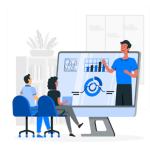The term “digital accessibility” refers to the capacity of all individuals, regardless of their abilities or limitations, to use digital products and services. Remember that only some people use digital products and services in the same way. Some people use them more frequently than others. A blind person, for example, can use a screen reader, but someone with a learning disability may require more plain information.
Enhancing the accessibility of your digital goods and services is not only the right thing to do; it will also benefit the success of your firm. You will be able to attract a larger audience, including those with disabilities if you make your products and services more accessible to the general public. Furthermore, as more countries pass legislation and establish accessibility standards, ensuring the accessibility of your products and solutions becomes increasingly crucial.
If you need help with your company’s digital accessibility, please get in touch with QualityLogic. We believe that accessibility is a right for every person, and we recognize how inconvenient it may be for persons with disabilities to be unable to examine certain circumstances. We would want to assist businesses in learning and growing. As a result, we will work with you to build the most effective accessibility strategy. Try some of the options listed below before calling.
Ways to Make Your Digital Products and Services More Accessible
You should seek expert counsel before beginning to create accessible material. The simplest way to ensure that your digital goods and services are available to all consumers is to develop them from the start. The initial phase in the design process is user research, which must continue through the coding stage. At each level, digital accessibility must be considered. Working with accessibility experts is also necessary to guarantee that your designs are as user-friendly as possible.
Make Sure That Your Material Is Simple to Comprehend
Even if it looks obvious, ensure that your information is clear and concise. This involves avoiding jargon and using plain language. It also entails making your material available in a variety of media types, such as audio and video, for clients that prefer or are required to consume information in various ways.
Take Caution When Taking Photographs and Videos
Images and videos are fantastic ways to augment the text and make it easier to grasp. To alleviate accessibility difficulties, a proper application is necessary. Make text equivalents for visual assets like images and videos so that those who can’t see them can understand what they’re saying. Check that your photos and videos have adequate contrast for persons with low vision to see.
It may be tough to ensure that your data and services are available in the digital age, but if you follow these criteria, you will be able to do so.
What Purpose Does Internet Access Serve?
According to the World Health Organization, disability is “an umbrella word that encompasses impairments, activity restrictions, and participation constraints.” Physical, sensory, cognitive, mental, and intellectual impairments are all examples of disabilities. One billion people will be crippled globally, making it one of the most common health problems. Despite this, people with disabilities face significant barriers to education, employment, and other critical services.
Making digital content and services available to everyone is one way to alleviate these constraints. This includes the development of websites and apps for those who are deaf or hard of hearing, blind or have poor vision or have a cognitive or intellectual handicap. We can help remove some of the barriers that people with disabilities face by making digital content and services more accessible, allowing them to live full and inclusive lives.
How Disabled People Use Digital Content
When it comes to interpreting digital information, people with disabilities have several challenges. Screen reader software, for example, may be required for blind or visually impaired persons to convert text to voice. Captions or subtitles may be required for deaf or hard-of-hearing people to get audio and visual information.
It may be necessary to simplify the presentation of content for those who have cognitive impairments. People with physical disabilities, for example, may require material access via switches or eye-gaze trackers, among other input modalities. Using these many criteria, website designers and developers may create digital content that is accessible to a wider audience.
Designing for the Blind and Visually Impaired
When it comes to digital data, please keep in mind that not everyone sees the world the same way. Those who are blind or have weak vision, for example, must rely on specific signals to comprehend information. As a result, additional considerations must be made while creating digital content for them. Image text descriptions, for example, must always be unique. Captions and audio explanations should be included in videos. You can ensure that everyone has access to your digital data by following these instructions.
Designing for Deaf People
When creating digital content, it is critical to consider the needs of all potential viewers. Those with disabilities who struggle with traditional sorts of media are catered to. Closed captioning, for example, can assist those who are deaf or hard of hearing in accessing digital information.
Several factors must be considered when creating digital content with closed captions. To begin, the captions must be easy to read and comprehend. This involves using large font sizes and avoiding using complex, difficult-to-read fonts. Subtitles should be synced with the audio track as well. This may be accomplished by manually writing the captions or transcribing the audio track and using software that automatically creates captions. The captions should then be thoroughly reviewed to verify that they are error-free.
If you follow these principles, you can create publicly available digital art. Closed captioning is one method for making your content more accessible; audio description and sign language interpretation are two more options. It is possible to create digital material that appeals to everyone by taking into consideration the needs of all viewers.
Content Beneficial to People With Cognitive Impairments
There are several challenges to consider when creating digital content for people with intellectual disabilities. Recognize that each person is unique and will necessitate a unique approach. However, there are a few fundamental guidelines that should be followed in order to improve content accessibility. Disability services, for example, recommend using simple language and graphics. This may assist the reader in understanding the subject and avoiding misunderstandings.
It is critical to provide a variety of opportunities for involvement and expression. People’s understanding and retention improve when they can interact with knowledge on their own terms.
Conclusion
Designers who follow these guidelines may create digital content that is both accessible and instructive to all clients. Click here to find out more about how QualityLogic may help you. With over 35 years of testing experience, we are a pioneer in digital accessibility and understand what it takes to make your site accessible to everyone. Even after we have assisted you in getting started with digital accessibility, we will continue to advise you. You can trust our specialists to guide you in the right direction, as we have done for thousands of others.

 Top 5 Benefits of Having a Trading Account for Investors
Top 5 Benefits of Having a Trading Account for Investors  Why Postcard Services Are a Game-Changer for Businesses and Organizations
Why Postcard Services Are a Game-Changer for Businesses and Organizations  A Key Role for Search Engine Optimization in the Expansion of Businesses Maximizing Online Presence
A Key Role for Search Engine Optimization in the Expansion of Businesses Maximizing Online Presence  5 Optimization Tips to Make Your Business More Efficient
5 Optimization Tips to Make Your Business More Efficient  Your Guide to Water Softening Equipment Suppliers: Key Factors to Consider
Your Guide to Water Softening Equipment Suppliers: Key Factors to Consider  Importance of Professional Heating and Air Conditioning Services for Year-Round Comfort
Importance of Professional Heating and Air Conditioning Services for Year-Round Comfort  The Importance of Corporate Culture for Company Setup in UAE
The Importance of Corporate Culture for Company Setup in UAE  Pre-purchase inspections – How do you read and understand the report?
Pre-purchase inspections – How do you read and understand the report?  Venture Capital and Investing in Today’s Workforce
Venture Capital and Investing in Today’s Workforce